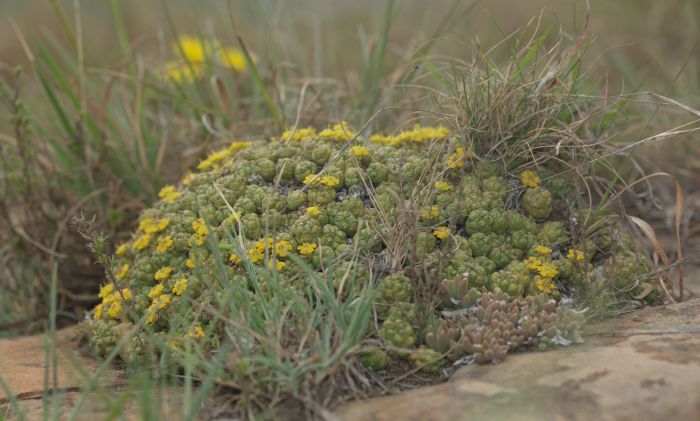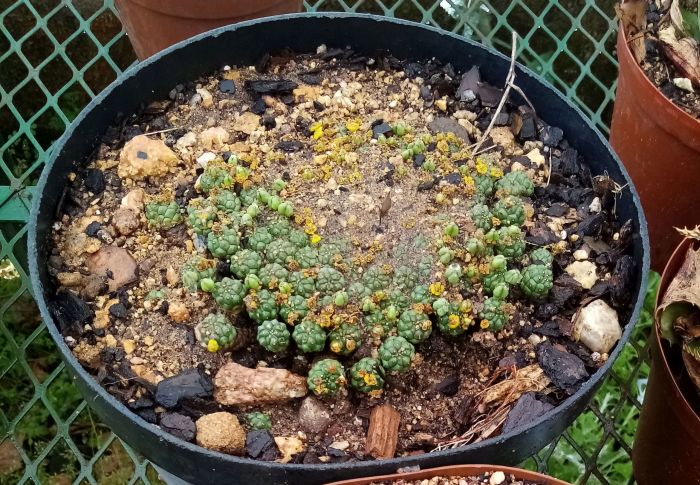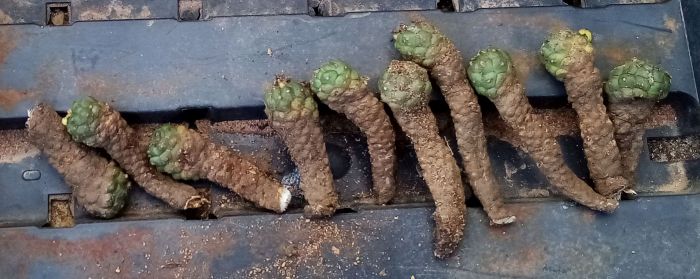Euphorbia clavarioides
Euphorbia clavarioides Boiss.
Family: Euphorbiaceae
Common names: lion’s spoor (Eng.), grootvingerpol, slangpol, melkpol (Afr.), isihlekehleke, isantilele (isiZulu), sehlehle, sehloko, thethebale (Sesotho)
Introduction
Euphorbia clavarioides is a succulent perennial that forms neat, cushion-like clumps of tightly packed stems, just above ground level, with beautiful yellow flowers in spring to early summer; it is one of the most hardy dwarf euphorbias.

Description
Description
Euphorbia clavarioides is one of many low-growing succulent plants. It forms a small, cushion-like mound, low on the ground, up to 50–70 mm high and 100–300 mm wide. The clump is composed of masses of cylindric, spineless, leafless, succulent stems, the tips forming the rounded edge of the cushion. The rootstock is a continuation of the main stem, which is fleshy, thick and buried underground, and covered all the way to the middle of the flattened body, by crowded branches. The main branches are cylindric and covered in tubercles. The leaves are small, fleshy, deciduous, 10–20 mm long and 5–10 mm wide, channelled all the way down the face, with a hairless surface. They are borne at the tips of the stems and soon fall off.

The inflorescences, known as cyathia, appear to be single flowers, but each is a cluster of very reduced flowers, inside a cup-like structure with petal-like bracts. The tiny flowers are unisexual and are reduced to a single stamen or a single ovary. The cyathia are solitary, stemless, yellow, have 3 to 5 bracts and are borne at the tips of the stems in spring and early summer (from September to February).

The fruit is a capsule, about 8 mm in diameter, attached directly by its base, without a stalk or peduncle, producing dark brown seeds that are 3.5 mm in diameter.
Conservation Status
Status
According to the Red List of South African plants website, the conservation status of this plant is Least Concern (LC).
Distribution and habitat
Distribution description
Euphorbia clavarioides is found growing in dry, rocky, steep areas of the Eastern Cape, Northern Cape, Western Cape, KwaZulu-Natal and Lesotho.
Derivation of name and historical aspects
History
The species name clavarioides means ‘like Clavaria’ and refers to the stems which superficially resemble the fruiting bodies of the basidiomycetes fungus genus Clavaria. The name of the genus Euphorbia dates back to the first century BC and King Juba the second of Mauritana; his doctor was called Euphorbus and his name was used as a generic name by Carl Linnaeus.

Ecology
Ecology
The flowers of Euphorbia clavarioides are a beautiful, bright yellow, which attracts bees, beetles, lady birds and other insects, which pollinate the flowers. The succulent stems store water, which allows it to survive periods of drought.

Uses
Use
The cushion-form euphorbias are used by the Basotho herd boys, who make shallow incisions on the stems, causing latex to bleed out of the plant, which they then allow to dry and collect it later and use it as chewing gum. This is however not recommended because the latex contains poisonous substances that may result in allergic reactions. E. clavarioides is also used in traditional medicine, dried and boiled, to treat swollen feet.
Horticulturally the plant is used as a pot plant, a focal plant and a border plant, well suited to rocky and steep areas in full sun, where it looks amazing. It needs well-drained soil with moderate water in summer and a dry winter. It is slow-growing and long-lived.

Growing Euphorbia clavarioides
Grow
Propagation can be by cuttings, where a clump is split and stems are cut off and allowed to dry for two days after applying a wound sealer. Prepare a soil mixture that is well-drained, plant the cuttings, irrigate gently and place in an area that allows filtered sunlight. Once rooted, hardening off is required prior to transplanting and placing in full sunlight, because the abrupt placing of the plant in full sunlight may scorch the stems.

The plant can also be propagated by seeds sown in spring or early summer.
Caution should be practised whenever handling any Euphorbia as the stems contain latex which may cause allergic reactions, thus always ensure the use of protective gloves and clothing and wash hands with soap and water after handling them.
References
- Archer, R. 2005. Euphorbia L. (Euphorbiaceae). PlantZAfrica. Internet. http://pza.sanbi.org/euphorbia
- Archer, R.H., Victor, J.E. & von Staden, L. 2014. Euphorbia clavarioides Boiss. National Assessment: Red List of South African Plants version 2020.1. Accessed 2021/08/31
- Bihrmann’s caudiciforms. Euphorbia clavarioides. http://www.bihrmann.com/caudiciforms/subs/eup-cla-sub.asp. Accessed 8 Sep. 2021.
- Bruyns, P.V. 2012. Nomenclature and typification of southern African species of Euphorbia. Bothalia 42(2): 217–245.
- Pooley, E. 2003. Mountain flowers, a field guide to the flora of the Drakensberg and Lesotho. Natal Flora Publications Trust, Durban.
- The encyclopaedia of succulents. Euphorbia clavarioides var. truncata. http://www.llifle.com/Encyclopedia/SUCCULENTS/Family/Euphorbiaceae/32951/Euphorbia_clavarioides_var._truncata. Accessed 18 Aug. 2021.
- Wikipedia. Clavaria. https://en.wikipedia.org/wiki/Clavaria. Accessed 8 Sep. 2021.
Credits
Bathabile Ndlovu
KwaZulu-Natal National Botanical Garden
September 2021
Plant Attributes:
Plant Type: Succulent
SA Distribution: Eastern Cape, KwaZulu-Natal, Northern Cape, Western Cape
Soil type: Sandy
Flowering season: Spring, Early Summer
PH:
Flower colour: Yellow
Aspect: Full Sun
Gardening skill: Average
Special Features:
Horticultural zones











Rate this article
Article well written and informative
Rate this plant
Is this an interesting plant?
Login to add your Comment
Back to topNot registered yet? Click here to register.